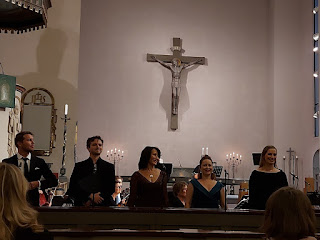Vaikka en ole suurin modernin oopperan fani, niin jotkut niistä tekevät syvän vaikutuksen ja ovat ehdottomasti näkemisen arvoisia. Kaisa Rannan tohtorintutkinnon ensimmäisenä konserttina esitetty Udo Zimmermannin Valkoinen ruusu on yksi tällaisista oopperoista. Teoksen oli ohjannut Ville Saukkonen ja Kaisa Ranta esitti Sophie Schollin roolin ja hänen veljenään Hansina lauloi Ville Rusanen.
Ooppera perustuu
tositapahtumiin. Valkoinen ruusu oli
1940-luvun Saksassa, Münchenissä syntynyt vastarintajärjestö, joka vastusti
natseja ja toista maailmansotaa rauhanomaisesti kirjoittamalla ja levittämällä natseja
kritisoivia lehtisiä. Vuonna 1943 sisarukset vangittiin ja tuomittiin maanpetoksesta
kuolemaan. Ooppera sijoittuu heidän viimeiseen yöhönsä vankilassa ja Wolfgang Willaschekin libretto perustuu sisarusten
päiväkirjamerkintöihin ja kertoo sisarusten ajatuksista ja muistoista.
Kaisa Rannan sopraano
sopi Sophien rooliin erinomaisesti. Tosin baritoni Ville Rusanen sopi Hansin
rooliin vielä paremmin siitä huolimatta, että rooli on kirjoitettu tenorille. Oopperan
säestyksestä huolehtivat Pasi Helin (piano) ja Marko Valtonen (harmonikka).
Instrumentit kuulostavat ehkä vähän erikoisilta oopperaan, mutta Zimmermannin
musikkiin ne sopivat erinomaisesti. Ja osaavien soittajien käsissä niiden ääni
välillä pauhasi, välillä kuiskasi luoden hienon tunnekudoksen.
Myös Ville Saukkosen
ohjausta on pakko kehua. Teos oli pienieleinen, mutta vaikuttava. Kokonaisuus
oli välillä suorastaan hypnoottinen ja vaikka ooppera ei varmasti oli
helpoimpia ymmärtää tai teemaltaan keveimpiä, niin se on ehdottomasti
katsomisen arvoinen.
Mielestäni illan suuri
tähti oli myös Titus Torniainen, joka vastasi valosuunnittelusta. Hän loi
muuten lähes pimeällä ja tyhjälle (lavasteina oli vain kaksi tuolia, huopaa ja
peltilautasta) lavalle valojen avulla vankisellit sekä kokonaisen elämän
muistoineen. Koska teoksessa ei ollut heijastettua tekstitystä ja pimeässä
salissa oli mahdotonta lukea tekstiä libretostakaan, niin Torniaisen valot
auttoivat ymmärtämään kunkin kohtauksen teemoja.



















